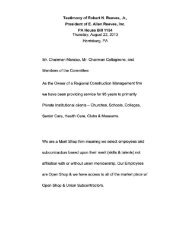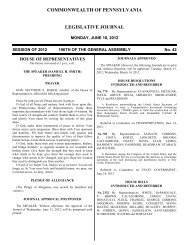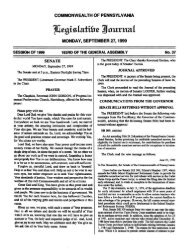Statement of Ronald B. Herberman, MD Chairman of Board ...
Statement of Ronald B. Herberman, MD Chairman of Board ...
Statement of Ronald B. Herberman, MD Chairman of Board ...
You also want an ePaper? Increase the reach of your titles
YUMPU automatically turns print PDFs into web optimized ePapers that Google loves.
most, for more than 10 years, have double the chance <strong>of</strong> developing malignant bmin tumors and<br />
also tumors on the hearing nerve, called acoustic neurwoas.<br />
Since my precautionary advisory in 2008, published peer-reviewed articles have provided<br />
mounting support for the concern about increased tumor risks. and other health risks, from longtenn,<br />
regular use <strong>of</strong> cell phones held against the head. Dr. Hardell found that when cell phone or<br />
cordless phone use began as a teenager or younger they had a 680% and 690% increased risk <strong>of</strong><br />
brain cancer on the side <strong>of</strong> the head where they held their phones, respectively. Theanalogous<br />
increased fisks when cell or cordless phone use began between 20 and 49 year <strong>of</strong> age were I 10%<br />
and 60%, respectively. Last year, the 13 country Interphone shmdy, sponsored by the World<br />
Health organization, finally published its findings, which also clearly indicated that frequent cell<br />
phone use for more than 10 years was associated with a significant, 118% increase in risk for<br />
developing brain tumors. In addition, an Israeli study indicated an increased risk fordevelopment<br />
<strong>of</strong> salivam gland tumors on the same side <strong>of</strong>the head as cell phone use. Row might this happen?<br />
Although RF radiation is considerably weaker than x-rays and we still don't understand well the<br />
molecular mechanisms, it has been shown that is ha3 dear biologic effects, including breakage <strong>of</strong><br />
DNA. A recent study by Dr. Volkow, Scientific Director <strong>of</strong> the Naiional institute <strong>of</strong> Drug Abuse,<br />
reported in JAMA that even expcsure <strong>of</strong> tho brain to RF for a few minutes changed brain<br />
metabolism, and several studies have indicated that males who cany their ccll phone in their<br />
pants pocket had significant decreases in sperm counts. Also, quite disconcerting are findings<br />
from Pr<strong>of</strong>. Nesrin Seyhan, the NATO-supported founding chairman <strong>of</strong> the Biophysics<br />
Department at Gazi University in Ankara, Turkey, who reported that prenatally RF-exposed<br />
rats and rabbits have fewer braln cells<br />
Very recently, the Wortd Health Organization bmughttogether a group <strong>of</strong> 30 experts &om 14<br />
nations who reviewed all known experimental and human studies regarding cell phones and<br />
cancer. Based largely on a detailed; careful review <strong>of</strong> human popul~ion-based studies, including<br />
some released just prior to the meeting, there was anear unanimous consensus (29-1) that regular<br />
use <strong>of</strong> cell phones is apossible cancer-causing exposure [see attachment 1 by Baan et all.<br />
Despite the mounting evidence for health risks from cell phone use, there certainly ale some<br />
studies that conclude no such health risks. It is understandable that the public remains confused<br />
about the science ou this issue. A very recent lepolt by Aydin et a1 that appeared in the Journal<br />
<strong>of</strong> the National Cancer Institute is a case In point, That study reported no increased risk <strong>of</strong> brarn<br />
cancer from 2004 to 2008 in children ages 7 to 19 who used cell phones. Industry-affiliated<br />
scientists who were ~nvited to provide a commentary on this study concluded that this study<br />
provided definitive and clear evidence that children face no increased risk at all fmm cell phone<br />
radiation Similarly, a recent report in Forfzme magazine reassured its readers that there is an<br />
absence <strong>of</strong> evidence for a current brain cancer epidemic.<br />
Hold your horses! Maybe you can trust Fortune with your money, but certainly this is not the<br />
besf source to rely on for predicting brain cancer risk. In my view, nothing could be further from<br />
the truth. There seem to be at least three likely explanations forthe reassuring negative<br />
conclusions in some reports: First, most such reports were supported at feast in part by the cell












